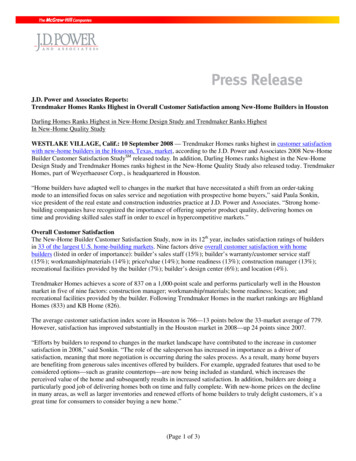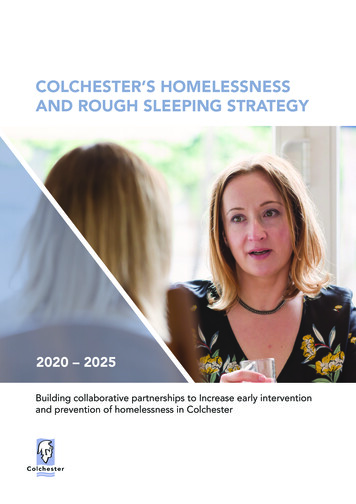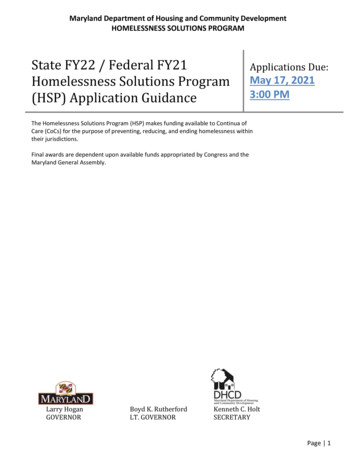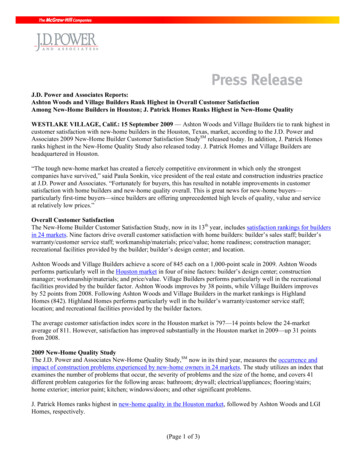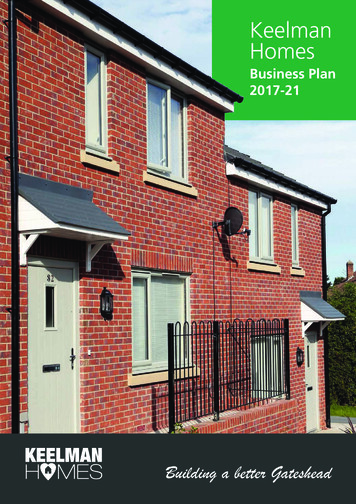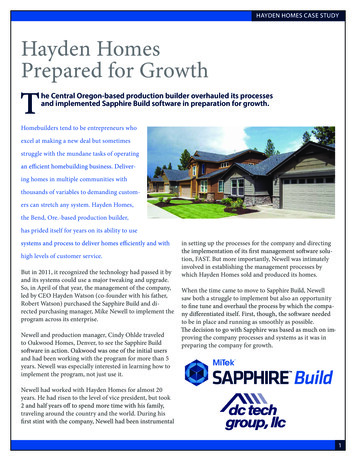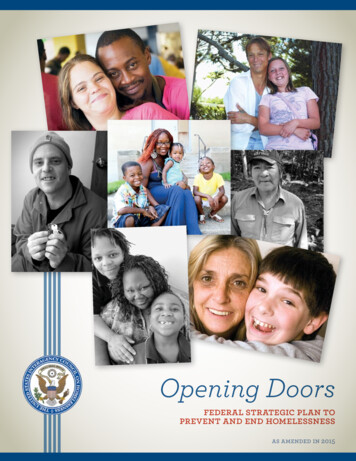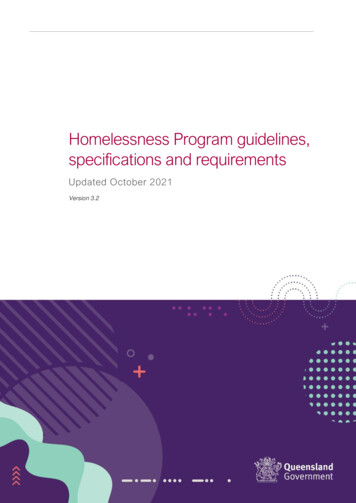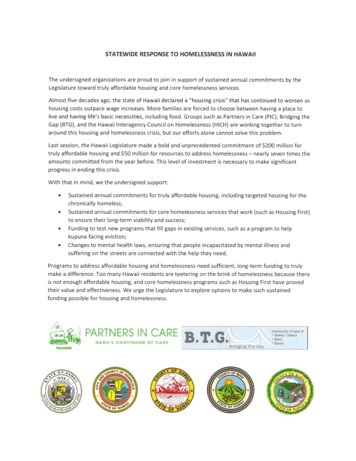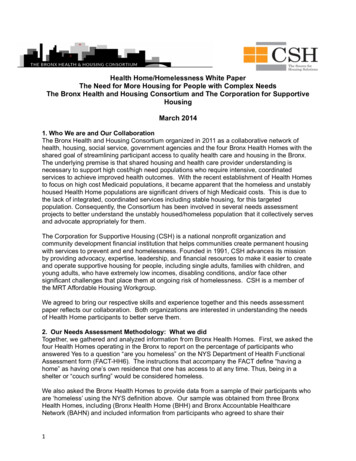
Transcription
Health Home/Homelessness White PaperThe Need for More Housing for People with Complex NeedsThe Bronx Health and Housing Consortium and The Corporation for SupportiveHousingMarch 20141. Who We are and Our CollaborationThe Bronx Health and Housing Consortium organized in 2011 as a collaborative network ofhealth, housing, social service, government agencies and the four Bronx Health Homes with theshared goal of streamlining participant access to quality health care and housing in the Bronx.The underlying premise is that shared housing and health care provider understanding isnecessary to support high cost/high need populations who require intensive, coordinatedservices to achieve improved health outcomes. With the recent establishment of Health Homesto focus on high cost Medicaid populations, it became apparent that the homeless and unstablyhoused Health Home populations are significant drivers of high Medicaid costs. This is due tothe lack of integrated, coordinated services including stable housing, for this targetedpopulation. Consequently, the Consortium has been involved in several needs assessmentprojects to better understand the unstably housed/homeless population that it collectively servesand advocate appropriately for them.The Corporation for Supportive Housing (CSH) is a national nonprofit organization andcommunity development financial institution that helps communities create permanent housingwith services to prevent and end homelessness. Founded in 1991, CSH advances its missionby providing advocacy, expertise, leadership, and financial resources to make it easier to createand operate supportive housing for people, including single adults, families with children, andyoung adults, who have extremely low incomes, disabling conditions, and/or face othersignificant challenges that place them at ongoing risk of homelessness. CSH is a member ofthe MRT Affordable Housing Workgroup.We agreed to bring our respective skills and experience together and this needs assessmentpaper reflects our collaboration. Both organizations are interested in understanding the needsof Health Home participants to better serve them.2. Our Needs Assessment Methodology: What we didTogether, we gathered and analyzed information from Bronx Health Homes. First, we asked thefour Health Homes operating in the Bronx to report on the percentage of participants whoanswered Yes to a question “are you homeless” on the NYS Department of Health FunctionalAssessment form (FACT-HH6). The instructions that accompany the FACT define “having ahome” as having one’s own residence that one has access to at any time. Thus, being in ashelter or “couch surfing” would be considered homeless.We also asked the Bronx Health Homes to provide data from a sample of their participants whoare ‘homeless’ using the NYS definition above. Our sample was obtained from three BronxHealth Homes, including (Bronx Health Home (BHH) and Bronx Accountable HealthcareNetwork (BAHN) and included information from participants who agreed to share their1
anonymized data. The sample of 428 individuals includes self-reported data aboutdemographics, entitlements, diagnoses, utilization and housing situation. The data sourcedocuments are the Assessments used by the Health Homes and their partners. While theAssessment tools used by the three Bronx Health Homes are similar, they are not identical. Asa result, we used data from questions that were worded almost identically on at least two of thethree Assessments, making the actual sample size for each variable reported on slightlydifferent.We also asked the Health Homes to provide sample Case Studies that illustrate how CareCoordinators address housing issues. A total of 13 cases were submitted by two Health Homes(Bronx Health Home and Bronx Accountable Healthcare Network).3. What We Found from the Data3.1 At the annual Bronx Health & Housing Consortium meeting in December 2013, the fourBronx Health Homes reported the percentage of enrollees who answered “Yes” to the NYSAssessment form question “Are you Homeless?”The Health and Hospitals Corporation (HHC) reported 22% of Health Home enrolleesacross the City were homeless. The Community Care Management Partners reported35% of their city-wide Health Home enrollees (2,549 of 7,284) were homeless. Lookingspecifically at Bronx Health Homes, we see similarly high numbers of homelessHealth Homes members, which is particularly concerning given that very few MRTfunded supportive housing beds have been allocated to the Bronx. The BronxHealth Home reported 23% (590 of 2,565) were homeless, and the Bronx AccountableHealthcare Network reported 20% (523 of 2,651). We do not have specific data forHHC, but the city-wide Community Care Management Partners found 2,549 of their7,284 enrollees were homeless. Therefore, if we use Bronx only data to estimate thepercentage of homeless Health Home members, 21% (1,113/5216) of Bronx HealthHome enrollees are self-reported homeless. These are significant numbers.At the same Consortium meeting, the NYS Department of Health reported 7,743 peopleenrolled in Bronx Health Homes. Thus 21% of 7,743 translates to 1,626 Bronx HealthHome participants living in homeless/unstably housed conditions. Even if theactual need for units is half this figure, there is a need for over 800 units in the Bronx for2
Health Home participants. Last year, there were about 50 MRT funded beds (22OMH and about 30 OASAS) allocated to the Bronx, all scatter site and for singleadults.3.2From our Health Home sample data-Demographics. This sample is fromself-reported assessment data.3.2.1 Median age 483.2.2 Gender - 42% Female, 58% Male3.2.3 Age - 14% over 60; 6% over 653.2.4 Family composition—28% are not single. (n 351)In this sample, 15% have children under 18 years of age living with themand 9% are two-adult households. The other 4% have children over 18years of age living with them (and no children under 18). So, of the 1,626units needed above, 28% of them should not be single or 'shared withother singles' units.3.2.5 Current living arrangements (n 374)30% live with friends or family—This is a very unstable situation formany Health Home participants as they are often ‘evicted’ from thesearrangements.28% live in rental apartments on their own. They reported they wereat-risk of losing their housing or unstable situations.22% live in shelters7% live in ¾ housing6% live in SROs3% live in public housing2% live in residential facilities2% are ‘homeless’3.2.6 Military- 1% reported they had served in the military. This means few canbenefit from VA housing.3.2.7 Incarceration (n 106)9% have history of incarceration. Housing options are limited forformerly incarcerated individuals.3.2.8 SSI/SSD (n 171)At least 40% have SSI or SSD or both. Thus there is high need forhousing for people with disabilities.3.2.9 Public Assistance-about 40% receive this public benefit3.2.10 Substance Abuse (drugs and alcohol)- Over a third report current or pastsubstance abuse. Some supportive housing is dedicated to people who are currentand/or past substance abusers. Some of these units are only available to people whoare currently under treatment by that organization. Thus, people receiving service from atrusted provider will be placed in a position of choosing potential housing and a newservice provider or continuing with their current services.3.2.11 Multiple medical and mental health diagnoses - 55% have at least 2 mentalhealth and 2 physical health self-reported diagnoses. We understand that thesedata usually under-represent mental health diagnoses as it is based on self-reporting.This population, with such complex conditions, often requires specialized housing andhealth care support.4.3What We Learned from Case StudiesAs a part of this study, we gathered 13 case examples. Care Coordinators wereasked to select cases that illustrate the difficulties Health Homes face in
supporting participants with housing needs. The qualitative data obtainedprovided a better picture of the care coordination challenges faced by homelessand unstably housed Health Home participants and their Care Coordinators.This qualitative data helped to contextualize what we surmised from thequantitative data.4.1About the Health Home Case Study Participants:1.1.1.1. Median age 441.1.1.2. Gender - 54% male, 46% female1.1.1.3. Disabilities - 67% have a physical disability, 58% have a serious mental illness(SMI)1.1.1.4. Over a third (36%) who responded to the question were formerly incarceratedHH Case Study Participants Household Composition0%15%Single AdultSingle Adult w/ Children31%54%2 Single Adults1.1.1.5. Household composition - more than half (54%) are single adults, 31% are singleadults with children and 15% are 2 single adults.1.1.1.6. A majority (62%) receive SSI, followed by food stamps (54%),4.2The respondents' median income is 749.4.3Some of the demographic data from these cases differs from the broadquantitative sample discussed in Section 3 above. Incarceration history (35% qualitativevs. 9% quantitative) and household composition (46% qualitative vs. 28% quantitativeare not singles) differed significantly, probably because Care Coordinators selecteddifficult cases and had more conversations with these participants that gave them moreinformation than the self-assessments used to collect the quantitative data. Otherfactors, such as median age and gender differences remained similar. What may beimportant for future research is to determine whether high-need frequent users withmore complicated circumstances may have higher criminal justice involvement and otherrisk factors that require a more intensive, expensive care management intervention.Research is needed to determine what characteristics individuals with complicatedcases share to better target extra resources to this already high-need, high-userpopulation.4
4.4Gaps and barriers identified:4.4.1 Scarce affordable housing options for individuals with limited fixedincomes. In several cases, the Health Home participants with compromising physicaldisabilities are not eligible for 2010e supportive housing and may not be able to affordthe rent if they were accepted into a housing program due to their very limited fixedincome. The case study group had a median income of 749, which in most cases is notenough to provide for housing and living expenses. Some people are being ‘evicted’ byfamily and friends and not able to support their own unit. Others live in unsafeconditions such as rat infested rooms. Additionally, most of the homeless respondentswere either on NYC Housing Authority's (NYCHA) waiting lists or found ineligible forvarious reasons (i.e. income, incarceration history etc.). In fact, one Health Homeparticipant had a NYCHA apartment but is unable to reside there due to his mentalhealth instability. Affordable housing options are not available on a scale to match need.4.4.2 Current Health Home system falls short in meeting the housing needs ofHealth Home participants with families. Almost half of the respondents in this sampleare living with family members - either with children and/or spouse. However most of theMRT supportive housing units and a significant proportion of the NY/NYIII housing units(NYC supportive housing initiative) are dedicated to single adults living in single roomoccupancies; therefore, many Health Home families would NOT be eligible.4.4.3 Housing providers with additional eligibility criteria serve as barriers toaccessing care/housing. In some examples, Health Home participants did not meetthe eligibility criteria for available disability-dedicated housing units, largely in part due tothe requirement that participants participate in treatment programs. In one case, theHealth Home participant with a substance use disorder was currently receiving treatmentin one community setting but recent acceptance into a housing program would requirehim to transfer treatment programs. This does not work for the participant as he feelsthat his current program provides critical social supports from both the staff and fellowpatients.4.4.4 Limited housing options for individuals with past criminal justiceinvolvement. Several housing programs have restrictions for individuals previouslyincarcerated, creating barriers to ending homelessness for these individuals.4.4.5 Care Coordinators are not housing specialists and have limited time andother resources to dedicate towards finding housing for their participants.Navigating through the various housing options that may be available to eligible HealthHome participants is a time-consuming and sometimes exhaustive process - even forthose who are familiar with the various housing options available. After an application issent to a housing provider, the follow-up can be extensive. One Health Home CareCoordinator reported placing over 100 calls for one participant in a matter of months,another reached out to over 300 contacts over the span of a year for one participant.Health Home Care Coordinators have very limited resources to dedicate to thenecessary, yet time-consuming, process of researching, identifying, referring andfollowing up with housing providers. As Health Homes continue to expand and enrollnew participants, this administrative burden will only escalate.4.4.6 Agency funding requirements were found to be rigid and not aligned withreal-life situations as well as not cost-effective. In one example, a Health Homeparticipant seeking housing through HASA came across several barriers due to HASA'sregulations. HASA will only approve 1,100 for an apartment, which limited her optionsin the Bronx. In addition, broker's fees must be paid in full and HASA will only cover halfthat amount. The participant is unable to afford the other half; however HASA would payfor her to stay in shelter - a far more costly option. Another participant lost a place in linefor an apartment due to repeated hospitalizations. Some Health Home participants need5
medications management or financial management support, which are not provided byall 2010e supportive housing providers. Thus the pool of available housing for them iseven more limited.4.4.7 Inability to place participants into housing may negatively impactparticipant & Health Home relationships. Several Health Home Care Coordinatorsnoted frustration in trying to find housing for their participants after exhausting allresources known to them. Many “reached a dead-end” in trying to find appropriate andavailable housing for their participant(s). This inability to address the housing needs ofparticipants may negatively impact the relationship between participants and their CareCoordinator and trusting their Care Coordinator’s ability to help them in general. CareCoordinators and Health Home participants are left frustrated by current housingavailability.4.4.8 Current system limitations. One Care Coordinator noted placing 20 calls toPATH that were unanswered. Another Care Coordinator noted that senior housing hadlong waiting lists which left the Health Home participant on a couch in an ‘unhealthy’environment. Several Health Home participants are on NYCHA waiting lists for yearsand Care Coordinators cannot identify other options.4.4.9 Pressures on Care Coordination. The absence of supportive housing thatparticipants need means that the services usually provided by supportive housing casemanagers must be provided by the Health Homes. When in supportive housing, casemanager and Care Coordinators can work together to ensure that all the participant’sneeds are being met.5.Conclusions—Policy Implications5.1Health Home participants have serious housing needs. Over twenty percent ofall Bronx Health Home participants are unstably housed/homeless. This need is notcurrently being met by MRT, NYNY III or any other source of safe, affordable housing.5.2NY needs broader housing eligibility criteria for those who are high utilizers ofMedicaid resources and other public resources (public assistance, criminal justice,shelter, etc.). A new NY/NY agreement should target people who are in this high utilizingcategory.5.3Units need to be larger so that families as well as single adults can access thehousing. We estimate that about 28% of the units needed to house Bronx Health Homeparticipants who are in family households (with other adults and/or children).5.4NY needs a centralized (can be statewide or regional, e.g. NYC and Upstate)housing assessment tool. Health Home Care Coordinators cannot make dozens or evenhundreds of calls to identify which housing is appropriate and then available for theirparticipants. A centralized clearing house for Health Homes that match participants withavailable housing for which they are eligible, based on this shared tool, is needed. MRTfunds and other sources should be used to provide housing available through thismechanism.5.5Health Homes have elderly populations that need other care/support. Sixpercent (6%) of the Bronx Health Homes enrollees are over age 65. If we assume atotal of 7,743 Health Home participants in the Bronx, then 465 older people havespecialized housing needs. In order to keep them out of costly nursing and adult homes,special supportive housing for the aging must be made available.5.6Other cases show the need for medications management, financial management(to avoid evictions) and other services that are not available from all supportive housingproviders. In some cases, the Care Coordinators may be able to refer out for theseservices, but in other cases they cannot. We need more resources within supportive6
housing and housing specialist positions to support this population to have better healthoutcomes and decreased resource utilization over time.5.7We found 40% of members in this study were receiving either SSI or SSD; casestudied members had even higher numbers for whom accessible housing was the onlyoption – and difficult to identify. Although it is not clear how many of these Health Homeparticipants require housing that is physically accessible, this is clearly an issue. Newhousing associated with Health Homes and in the general pipeline must include unitsthat are accessible to physically disabled participants. Handicapped 'adaptable units' areinadequate—units that are truly accessible and available are needed now. Currentsupportive housing with ‘adaptable units’ should be funded to become accessible uponturnover and offered to individuals who are physically disabled.5.8While scatter-site supportive housing units bring units on-line quickly, morecongregate housing is necessary for participants with intense need. This is especiallytrue as people often have co-occurring mental and physical diagnoses.5.9Health Home participants with housing needs and complex conditions requiremore resources for effective Care Coordination.Since housing needs are basic and we know that Health Home participants often do notaddress their health needs until their housing is stable, we need to focus on responding to theneed for stable housing for this population as soon as possible.7
The Bronx Health Home reported 23% (590 of 2,565) were homeless, and the Bronx Accountable Healthcare Network reported 20% (523 of 2,651). We do not have specific data for HHC, but the city-wide Community Care Management Partners found 2,549 of their 7,284 enrollees were homeless. Therefore, if we use Bronx only data to estimate the
